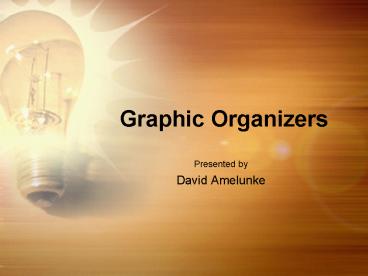Graphic Organizers - PowerPoint PPT Presentation
1 / 22
Title:
Graphic Organizers
Description:
Learn when to use the various types of Graphic Organizers ... Patterns organize information into a casual network leading to a specific outcome ... – PowerPoint PPT presentation
Number of Views:56
Avg rating:3.0/5.0
Title: Graphic Organizers
1
Graphic Organizers
- Presented by
- David Amelunke
2
Objectives
- Learn what research shows about the use of
Graphic Organizers on student achievement - Learn when to use the various types of Graphic
Organizers - Learn methods to create Graphic Organizers
- Generate ideas for use of Graphic Organizers in
your classroom
3
Vocabulary
- Nonlinguistic Representations - imaginary forms
of knowledge in the mind such as mental pictures
or even physical sensations - Visual Learning - a variety of activities and
systems for organizing information graphically or
visually - Graphic Organizers - visual depictions of
knowledge that help guide the thinking process
4
Nonlinguistic Representations
Information from Classroom Instructions That
Works Research Based-Strategies for Increasing
Student Achievement by Robert Marzano, Debra
Pickeringand Jane E. Pollock
5
Storing Information
- Many Psychologists adhere to a dual coding
theory of information storage - This theory says that knowledge is stored in the
brain in two forms - a linguistic form and an
imagery form
6
Linguistic
- The linguistic form is in words or statements
- This form could be thought of as containing
actual statements in long-term memory
Imagery/Nonlinguistic
The imagery form is expressed as mental pictures
or even physical sensations such smell, taste,
touch, sound and kinesthetic association
7
Using Both
- The more we use both systems of representation
the better we are able to think about and recall
knowledge - This is particularly important in the classroom
because linguistically is the primary method of
presenting knowledge in the classroom - We either talk to students about content or they
read about new content - This means students are left to generate their
own nonlinguistic representations
8
Increasing Student Achievement
- When teachers help students make non-linguistic
representations students achieve more - Engaging students in the creation of
nonlinguistic representations stimulates and
increases activity in the brain
9
Generalizations RegardingNonlinguistic
Representations
- A variety of activities produce nonlinguistic
representations - The goal of instructional strategies is to
produce nonlinguistic representations of
knowledge in the minds of students - It can be accomplished in many ways
- Creating Graphic Representations
- Making Physical Models
- Generating Mental Pictures
- Drawing Pictures and Pictographs
- Engaging in Physical Activities
10
Generalizations RegardingNonlinguistic
Representations
- Nonlinguistic representations should elaborate
on knowledge. For example a student can elaborate
on his knowledge of fractions when he constructs
a mental model of how a fraction might appear in
concrete form - The process of generating nonlinguistic
representations forces students to elaborate on
their knowledge and leads to deeper understanding
and easier recall of information
11
Classroom Practice inNonlinguistic
Representations
- Graphic Organizers are the most common way to
help students generate nonlinguistic
representations - Graphic Organizers combine the linguistic mode
in that they use words and phrases and the
nonlinguistic mode in that they use symbols and
arrows to represent relationships
12
- Graphic Organizers have great utility in the
classroom because they correspond to six common
patterns that information can be divided into - Descriptive pattern
- Time sequence pattern
- Process/cause-effect pattern
- Episode pattern
- Generalization/principle pattern
- Concept pattern
13
Descriptive Pattern
- Descriptive Patterns can be used to represent
facts about specific people, places, things and
events - This information does not have to be in any
specific order
14
Descriptive Pattern
Example
15
Time Sequence Pattern
- Time sequence patterns organize events in a
specific chronological order - For example, the events leading up to the Vietnam
War can be shown in a time sequence pattern
organizer
16
Process/Cause-Effect Pattern
- Process/Cause-Effect Patterns organize
information into a casual network leading to a
specific outcome
- An example would be study habits that make a good
student
17
Episode Pattern
- Episode Pattern Organizers arrange data about
specific events including - Setting (time and place)
- Specific People
- A specific duration
- A specific sequence of events
- A particular cause and effect
An Example would be information leading up to the
Civil War
18
Episode Pattern
An Example would be information leading up to the
Civil War
19
Generalization/Principle Patterns
- Gereralization/Principle Patterns organize
information into general statements with
supporting details. - An Example would be statements supporting a
hypothesis that economic conditions were the
cause of the Civil War.
20
Concept Pattern
- Concept Patterns organize information around a
word or phrase that represents entire classes or
categories of people, places things or events - The characteristics or attributes of the concept
along with examples of each should be included in
this example. - An example would be a teacher asking a student to
show the concept of fables along with examples
and characteristics of them.
21
Concept Pattern
A Concept Pattern could look like this
22
So how do you makea Graphic Organizer and what
software can you use?































